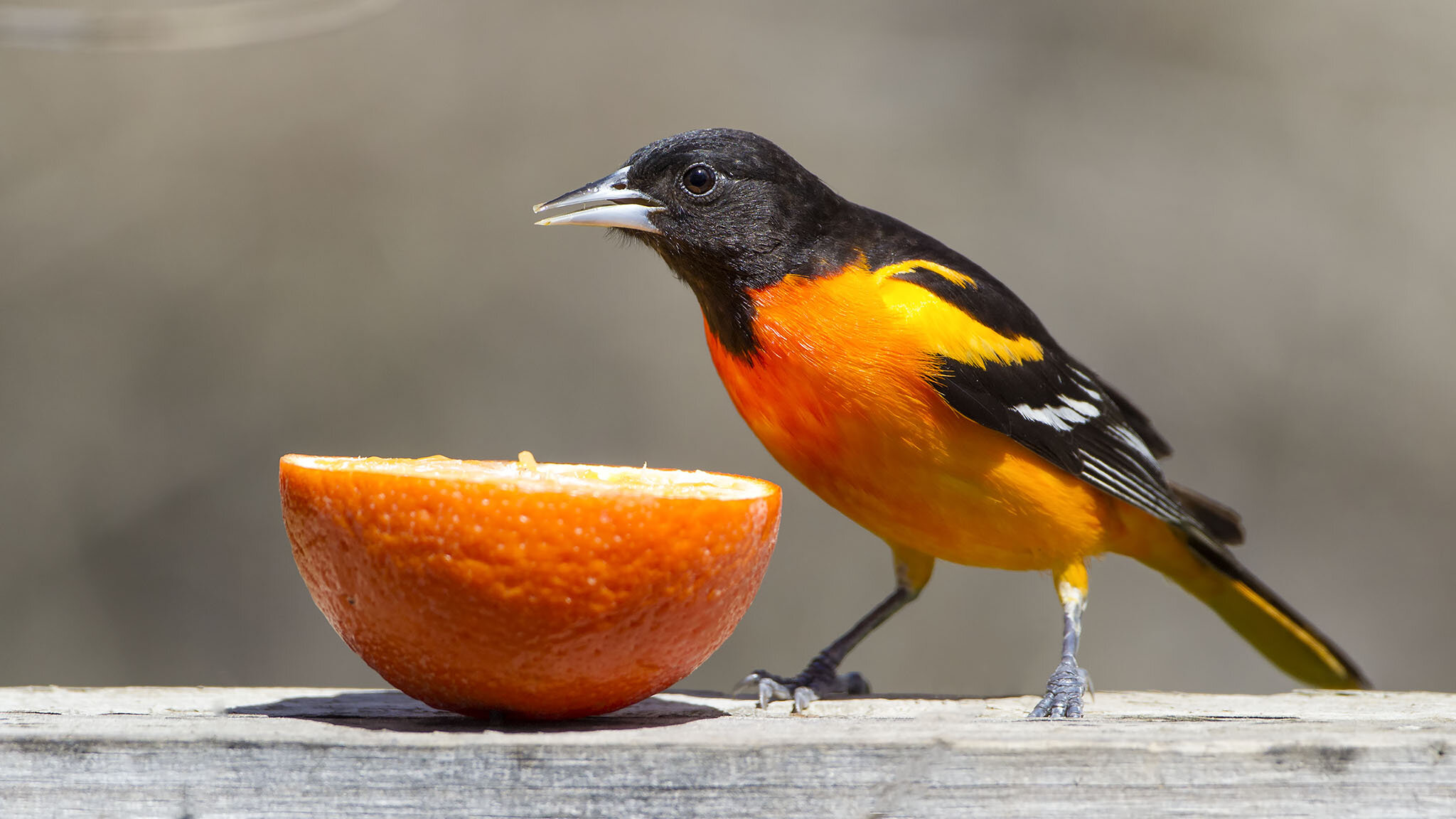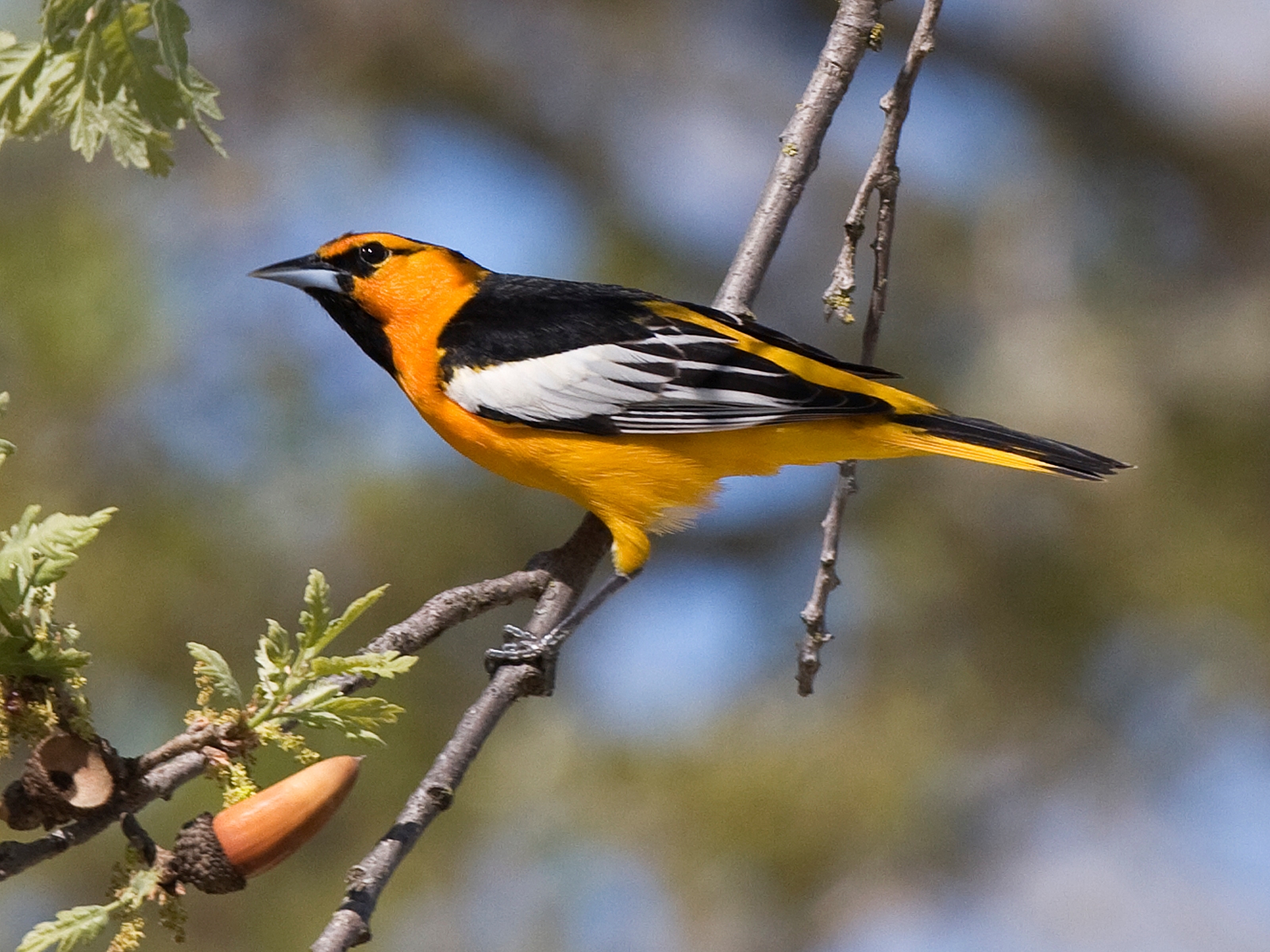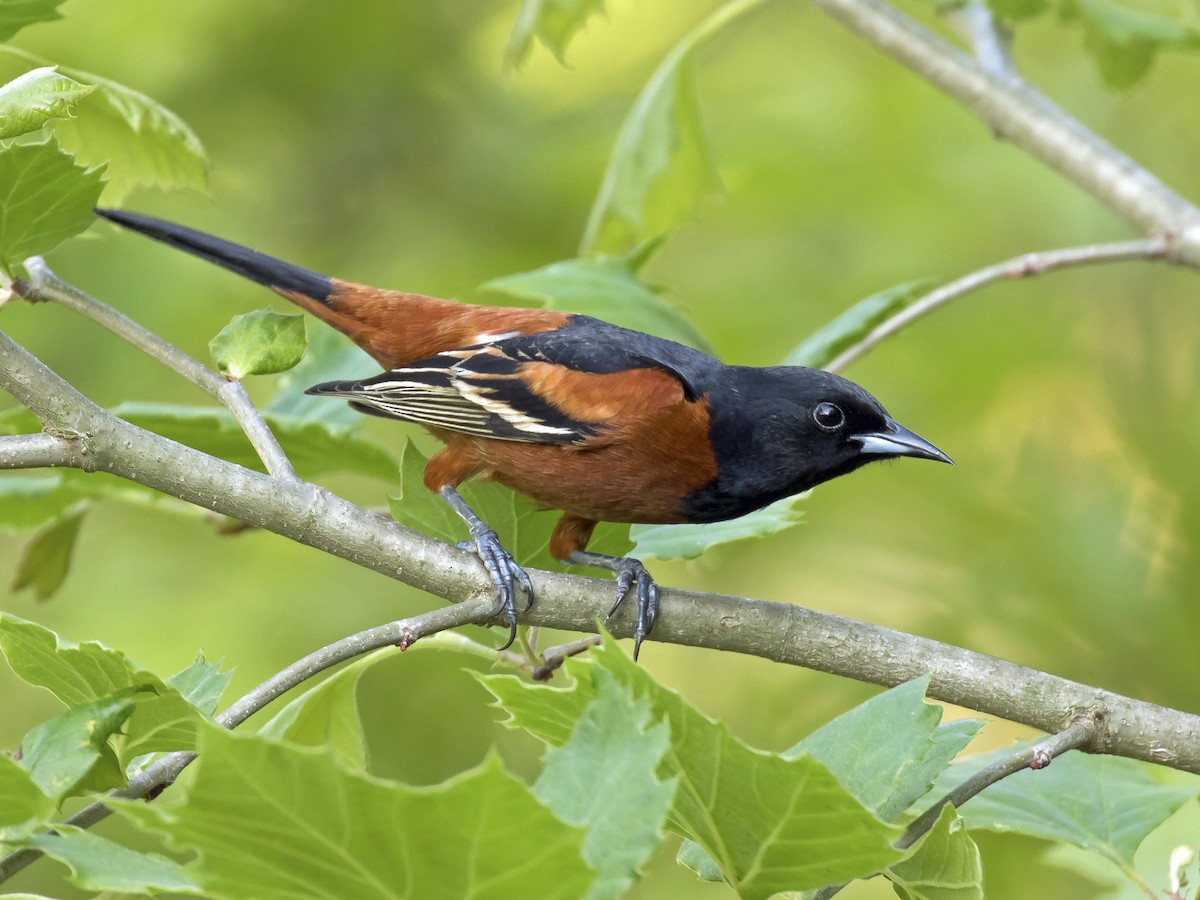Orioles are a group of brightly colored songbirds that are found in both the Old World and the New World. In North America, there are nine different types of orioles that are typically migratory.
They are known for their slender bodies, long tails, and pointed bills. Orioles are insect eaters and are found in woodlands, forests, scrub, and backyards.
You are reading: View All 9 Types Of Oriole Birds
In this article, we will explore the nine types of oriole birds found in North America, their habitats, range, and behavior.

9 Types Of Oriole Birds
Baltimore Oriole
The Baltimore Oriole (Icterus galbula) is a small icterid blackbird that is common in eastern North America as a migratory breeding bird. It is the state bird of Maryland and is also the namesake and mascot for the Baltimore Orioles baseball team.
Baltimore Orioles are medium-sized, sturdy-bodied songbirds with thick necks and long legs. They are smaller and more slender than an American Robin. The male Baltimore Oriole has brilliant orange-golden underparts and shoulder patches, with black wings and a black head, while females are not as brightly colored and have brownish-olive plumage.
Baltimore Orioles are often seen perched at the tops of trees or flitting through the upper foliage in search of insects. They have a distinctive chatter, which is unlike the call of any other bird where orioles occur.
Read more : Ground Feeder For Birds
Baltimore Orioles seek out ripe fruit and can be attracted to backyards with cut oranges or special oriole feeders filled with sugar water.
Bullock’s Oriole

Bullock’s Oriole (Icterus bullockii) is a small New World blackbird that is found in the western United States and Mexico. Here are some key facts about the Bullock’s Oriole:
Appearance:
– Medium-sized songbird with slim but sturdy bodies and medium-long tails.
– Males have a large white wing patch and mostly orange face with a black eyeline.
– Females are less brightly colored and have a yellowish-orange head and breast, with brownish-gray upperparts.
Habitat and Behavior:
– Nimble canopy-gleaners of open woodlands in the western U.S. .
– Forages by hanging upside down from branches and weaving its remarkable hanging nest.
– Feeds mostly on insects, especially caterpillars, beetles, grasshoppers, crickets, wasps, and spiders, and also eats berries and nectar.
Taxonomy:
– Bullock’s Oriole was once considered to be the same species as the Baltimore Oriole, known as the Northern Oriole.
– The bird is named after William Bullock, an English amateur naturalist.
– Bullock’s Oriole is classified under the Kingdom Animalia, Phylum Chordata, Class Aves, Order Passeriformes, Family Icteridae, Genus Icterus, and Species I. bullockii.
Orchard Oriole

The Orchard Oriole (Icterus spurius) is a small, slim songbird that is found in eastern North America. Here are some key facts about the Orchard Oriole:
Appearance:
– Males have a black head and throat, with a reddish-chestnut patch at the bend of the wing, and are black above and rich reddish-chestnut below.
– Females are olive-green above and yellowish below, with two white wingbars and a whitish eye-ring.
– Both sexes have a straight, sharply pointed bill and medium-length tails.
Habitat and Behavior:
– Orchard Orioles breed in open woodlands, forest edges, and riparian areas with scattered trees.
– They forage for insects and spiders in the upper canopy of trees and shrubs.
– Orchard Orioles are known for their hanging basket nests, which are woven from grass and plant fibers and lined with fine grass and plant down.
– They are migratory birds and spend winters in Central America and northern South America.
Taxonomy:
– Orchard Oriole is classified under the Kingdom Animalia, Phylum Chordata, Class Aves, Order Passeriformes, Family Icteridae, Genus Icterus, and Species I. spurius.
Scott’s Oriole
Scott’s Oriole (Icterus parisorum) is a medium-sized songbird that is found in the southwestern United States and Mexico. Here are some key facts about the Scott’s Oriole:
Appearance:
– Males have black plumage with bright yellow underparts, wings, and tail feathers.
– Females are duller in color, with olive-yellow upperparts and yellowish underparts.
– Both sexes have a long, straight, spikelike bill and a medium-length tail.
Habitat and Behavior:
– Scott’s Orioles inhabit high deserts and the mountain slopes adjacent to them, where they nest and forage in tall yuccas, palms, junipers, and other trees and shrubs.
– They are known for their beautiful and complex songs, which are often heard in the early morning.
– Scott’s Orioles feed on insects, nectar, and fruit, and are often seen hovering at flowers to feed on nectar.
– They are migratory birds and spend winters in Mexico and Central America.
Taxonomy:
– Scott’s Oriole is classified under the Kingdom Animalia, Phylum Chordata, Class Aves, Order Passeriformes, Family Icteridae, Genus Icterus, and Species I. parisorum.
Streak-Backed Oriole
The Streak-backed Oriole (Icterus pustulatus) is a medium-sized passerine bird from the icterid family, native to Central America and Mexico, and an occasional visitor to the United States. Here are some key facts about the Streak-backed Oriole:
Appearance:
– Slightly larger and bulkier than the Hooded Oriole, with a straighter bill and more extensive white edgings to the wing feathers.
– Males have a black head and upperparts, with a bright yellow-orange underparts and a distinctive black streak down their back.
– Females are similar in appearance but duller in color.
Habitat and Behavior:
– Streak-backed Orioles inhabit arid to semiarid areas of brushy woodland and scrub.
– They feed heavily on insects and spiders, but will also eat fruit and nectar.
– Streak-backed Orioles are known for their beautiful and complex songs, which are often heard in the early morning.
– They are migratory birds and spend winters in Central America and northern South America.
Taxonomy:
– Streak-backed Oriole is classified under the Kingdom Animalia, Phylum Chordata, Class Aves, Order Passeriformes, Family Icteridae, Genus Icterus, and Species I. pustulatus.
Hooded Oriole
The Hooded Oriole (Icterus cucullatus) is a medium-sized New World oriole that is found in the southwestern United States and Mexico. Here are some key facts about the Hooded Oriole:
Appearance:
– Males have bright orange-yellow underparts, with a black face, back, tail, and bib, and two white wingbars.
– Females are olive-yellow above and yellowish below, with two white wingbars and a whitish eye-ring.
– Both sexes have a long, straight, sharply pointed bill and a medium-length tail.
Habitat and Behavior:
– Hooded Orioles inhabit open woodlands, shade trees, palms, and suburban neighborhoods with palm trees.
– They feed on insects, nectar, and fruit, and are often seen hovering at flowers to feed on nectar.
– Hooded Orioles are known for their beautiful and complex songs, which are often heard in the early morning.
– They are migratory birds and spend winters in Mexico and Central America.
Nesting:
– Hooded Orioles are among the most interesting of nest builders, actually sewing filaments through leaves to achieve a nest which hangs like a hammock.
– They build their nests in palm trees, and the female pokes holes in the leaf from below and pushes the fibers through, effectively sewing the nest to the leaf.
Taxonomy:
– Hooded Oriole is classified under the Kingdom Animalia, Phylum Chordata, Class Aves, Order Passeriformes, Family Icteridae, Genus Icterus, and Species I. cucullatus.
Spot-Breasted Oriole
Read more : How To Keep Ants Out Of Bird Feeder
The Spot-breasted Oriole (Icterus pectoralis) is a mid-sized songbird and a member of the Icteridae family. Here are some key facts about the Spot-breasted Oriole:
Appearance:
– The Spot-breasted Oriole is bright orange overall with a black bib and black spotting on the sides of the breast.
– The sexes are similar looking generally but females and juveniles are olive-green on the back and tail, dusky wings, and little or no black on face, throat, or breast.
– Adults measure 21–24 cm (8.3–9.4 in) in length. Males weigh around 50 g (1.8 oz) on average, while females weigh 45 g (1.6 oz).
Habitat and Behavior:
– The Spot-breasted Oriole ranges only on the Pacific side of Central America, from southern Mexico to Panama.
– They inhabit the Pacific coastal lowlands, interior, and Caribbean lowlands of northern Central America.
– Spot-breasted Orioles are known for their beautiful and complex songs, which are often heard in the early morning.
– They feed on insects, nectar, and fruit.
Taxonomy:
– Spot-breasted Oriole is classified under the Kingdom Animalia, Phylum Chordata, Class Aves, Order Passeriformes, Family Icteridae, Genus Icterus, and Species I. pectoralis.
– An introduced breeding population also exists on the Atlantic coast of southern Florida.
Altamira Oriole
The Altamira Oriole (Icterus gularis) is a New World oriole that is widespread in subtropical lowlands of the Mexican Gulf Coast and northern Central America, the Pacific coast, and inland. Here are some key facts about the Altamira Oriole:
Appearance:
– Large, bright orange oriole with a thick, dark bill.
– Limited black on face and throat; black back and wings with white wingbars.
– Males and females look similar, but females are slightly duller in color.
Habitat and Behavior:
– Altamira Orioles inhabit open shrubby woodland, forest edges, and riparian areas.
– They are solitary nesters, with an average of about 800 feet between nests.
– Altamira Orioles are forage gleaners, searching for food through the treetops to the near-ground bottom of the tree.
– Their diet includes fruit (small fruits, hackberries, and figs) and insects, such as grasshoppers, crickets, and caterpillars.
– Altamira Orioles are known for their clear, slow musical whistles, as well as harsh whistles, rasping chatter, and nasal “ike”s.
Range and Conservation:
– Altamira Orioles are year-round residents in northeastern Mexico and have since spread to southern Texas, but this was not until 1939.
– They are not considered threatened, but their populations are declining due to habitat loss and fragmentation.
Taxonomy:
– Altamira Oriole is classified under the Kingdom Animalia, Phylum Chordata, Class Aves, Order Passeriformes, Family Icteridae, Genus Icterus, and Species I. gularis.
Audubon’s Oriole
Audubon’s Oriole (Icterus graduacauda) is a New World passerine bird that inhabits the forests and thickets of southeastern Texas and the Mexican coast. Here are some key facts about the Audubon’s Oriole:
Appearance:
– The Audubon’s Oriole is the only species to have a black hood and yellow body.
– It has an entirely yellow body with a greenish back and black hood.
– Young birds are slightly paler than adults and develop a black hood within a couple of months of hatching.
Habitat and Behavior:
– Audubon’s Orioles inhabit dense evergreen forests and thickets, preferring riparian (riverside) areas.
– They are shy and elusive birds that are difficult to spot.
– Audubon’s Orioles are known for their pleasing, rising-and-falling whistles.
– They feed on insects, fruit, and nectar.
– Audubon’s Orioles are year-round residents of southern Texas, eastern and southern Mexico, and the northern tip of Central America.
Taxonomy:
– Audubon’s Oriole is classified under the Kingdom Animalia, Phylum Chordata, Class Aves, Order Passeriformes, Family Icteridae, Genus Icterus, and Species I. graduacauda.
FAQS
1. What are the nine types of oriole birds found in North America?
– Baltimore Oriole
– Bullock’s Oriole
– Orchard Oriole
– Scott’s Oriole
– Streak-Backed Oriole
– Hooded Oriole
– Spot-Breasted Oriole
– Altamira Oriole
– Audubon’s Oriole
2. What do orioles eat?
Orioles feed on insects, fruit, and nectar. Some species are known to feed on grape jelly, oranges, and sugar water from special feeders.
3. Where do orioles live?
Orioles are found in a variety of habitats, including woodlands, forests, scrub, backyards, and riparian areas. The specific habitat depends on the species.
4. Are orioles migratory birds?
Yes, most orioles are migratory birds that spend winters in Central America and northern South America.
5. How can I attract orioles to my backyard?
Orioles can be attracted to backyards with cut oranges or special oriole feeders filled with sugar water. Some species are also attracted to grape jelly.
6. Are orioles endangered?
Most oriole species are not considered threatened, but their populations are declining due to habitat loss and fragmentation.
Source: https://petstutorial.com
Category: Birds










